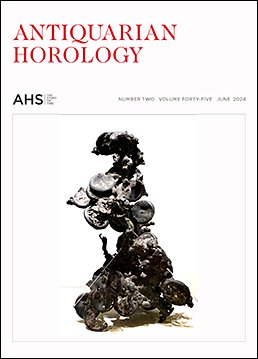Current issue of Antiquarian Horology

Volume 45, Issue 2 June 2024
On the front cover: Seiko Museum fusion of customer watches burned and melted during the 1923 great earthquake. Dug from the ruins of the Seikosha shop. Photo Bob Frishman.
For details see his article Horology in Tokyo in this issue.
This issue contains the following articles:
Clockwork Treasures from China’s Forbidden City – an exhibition review
by Ian White (pages 166-175)
Summary: Zimingzhong: Clockwork Treasures from China’s Forbidden City was the title of an exhibition held at the Science Museum in London from 1 February to 2 June 2024. It was initially planned for 2020, but was postponed because of the pandemic. It brought to London an unprecedented exposure of the great skills of London clockmaking aimed at a totally different market from that of Europe. The exhibits came from the Palace Museum in Beijing, which has the largest collection of clocks in the world, a collection made by the Emperor Ch’ien-lung, who reigned from 1736 to 1796
Dismantling the ‘East School’ – Edward East and the clock trade in seventeenth-century London
by Richard Newton (pages 176-196)
Summary: The article summarises a London Lecture given by the author on 13 July 2023 and suggests that Edward East was acting principally as a retailer of clocks manufactured by others. By examining the movements of clocks signed by East we can see that they correspond with the work of John Hilderson, Ahasuerus Fromanteel, William Clement, Samuel Knibb and others. Further groups of movements from a common source but different signatures can also be identified and suggestions as to the maker are made. (Read this article here)
John Hilderson (?–1665): An update
by James Nye (pages 197-205)
Summary: To date, our knowledge of John Hilderson has best been brought together in the substantial piece of work by Anthony Weston in the June 2000 edition of Antiquarian Horology. Richard Newton’s recent work revealing Edward East’s sources for movements confirmed John Hilderson as the source for East’s pendulum clock movements in the first half of the 1660s (see Richard’s article in this journal). The recent discovery of the 1666 inventory of Hilderson’s house and workshop prompts a re-evaluation of our knowledge of the details of this important early maker.
Watertight pocket watches known as explorers’ watches, retailed by Herbert Blockley & Co., 41 Duke Street, St James, London
by Simon Davidson (pages 206-216)
Summary: This paper examines the retailing by Herbert Blockley & Co. of watertight pocket watches manufactured by Usher & Cole, known as explorers’ watches, to meet the need for accurate timekeeping in humid conditions. It met a need amongst the public travelling or working particularly in polar or tropical or latitudes, and is also illustrated by the Royal Geographical Society adopting this case model for supply to their sponsored expeditions. The paper highlights the output and the two models of watertight watches that Herbert Blockley retailed over the period 1890 to 1917.
Travel journals and the history of horology
by Peter de Clercq (pages 217-235)
Summary: Travel journals contain valuable information for historians, and this includes those who have a special interest in the history of horology. This article, an edited version of the Dingwall-Beloe Lecture delivered at the British Museum on 17 November 2022, offers horological information gleaned from the travel journals written by the Frenchman Balthasar de Monconys (1608–1665), the Englishman Philip Skippon (1641–1691) and the German Heinrich Sander (1754–1782). Neither of them had practical experience or personal involvement with clocks and watches, and this article concludes with a discussion of similar documents recording travels undertaken by two men who were actively involved in the trade: the Swiss clockmaker Pierre Jaquet-Droz (1721–1790) and the English clockmaker James Upjohn (1722–1794).
Picture Gallery: An unrecorded early pendulum clock
by Richard Newman (pages 236-240)
Summary: The clock illustrated and discussed in this article was made in 1666 by Johann Koch who was the clockmaker to King Charles XI of Sweden.
Museum profile: Horology in Tokyo
by Bob Frishman (pages 241-246)
Summary: This article presents the Daimyo Japanese Clock Museum, the National Museum of Nature and Science and the Seiko Museum.
Berthoud 1759: a bibliographical note
by Anthony Turner (pages 247-250)
Summary: Examination of several copies of Berthoud’s first publication L’Art de conduire et de régler les pendules et les montres : à l’usage de ceux qui n’ont aucune connoissance d’horlogerie has allowed the true second edition to be distinguished from a pirate edition that was hitherto thought to be that.
‘Unfreezing Time #18’ by Patricia Fara (pages 260-261) (Read the whole series of articles here)
The issue totals 148 pages and is illustrated mainly in colour, and is completed by the regular sections Horological News, Book Reviews, Unfreezing Time, Notes from the Librarian, AHS News, Letters and Further Reading.